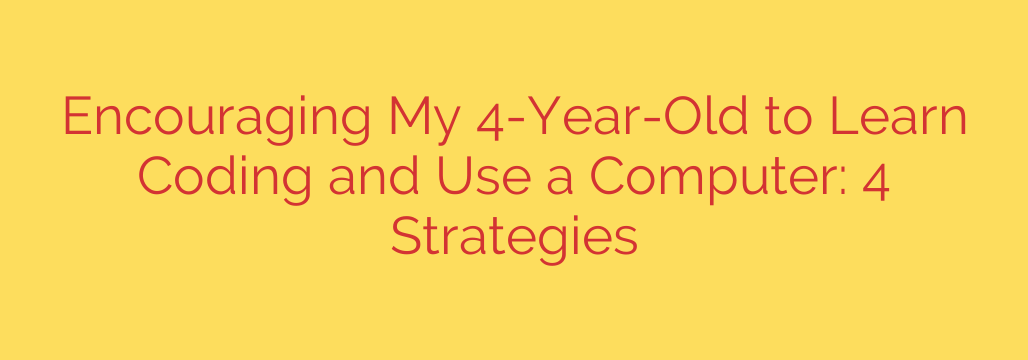
How to Introduce Your Preschooler to Coding: A Parent’s Guide
In today’s digital world, it’s natural for parents to wonder how they can prepare their children for the future. You might hear about “coding for kids” and ask yourself: is my four-year-old really ready to learn programming? The answer is a resounding yes, but probably not in the way you think.
Introducing a preschooler to coding isn’t about sitting them in front of a complex screen of text-based commands. Instead, it’s about nurturing the foundational skills behind coding: logic, problem-solving, sequencing, and creative thinking. These are the building blocks of what experts call “computational thinking,” and you can start teaching them today.
Here are four effective strategies for introducing your young child to the world of computers and coding in a fun, healthy, and age-appropriate way.
1. Start with “Unplugged” Coding Activities
Before you even turn on a device, you can teach the core concepts of coding through everyday play. The goal is to build a mental framework for how instructions work. Unplugged activities are perfect for this, as they translate abstract ideas into tangible, hands-on experiences.
Simple activities can lay a powerful groundwork:
- Building with Blocks: Following instructions to build a specific structure teaches sequencing and spatial reasoning. Giving them a “challenge,” like building a bridge that can support a toy car, encourages problem-solving and iteration.
- Following a Recipe: Baking cookies together isn’t just a fun activity; it’s an algorithm. Each step must be followed in the correct order to achieve the desired result.
- Creating an Obstacle Course: Have your child design an obstacle course in the living room and write down the “program” to get through it: “Take three big steps, crawl under the table, then hop to the cushion.” This teaches them how to create and execute a sequence of commands.
Focus on teaching computational thinking—like sequencing, patterns, and problem-solving—through everyday play. These screen-free methods build the essential logic your child will need for any future digital endeavors.
2. Gamify Learning with Age-Appropriate Tools
Once your child understands the basic logic of sequencing and commands, you can introduce them to carefully selected digital tools. For preschoolers, the key is to make it a game. Modern coding toys and apps are designed to be intuitive, visual, and engaging.
Look for tools that use block-based coding, where children can drag and drop visual blocks of commands instead of typing.
- Coding Robots: Toys like the Code & Go Robot Mouse or Cubetto allow children to physically program a robot to navigate a maze or travel to a destination. They see a direct, physical result of their “code.”
- Simple Coding Apps: Applications like ScratchJr are designed for children ages 5-7 (but are often accessible to curious 4-year-olds with help). They allow kids to snap together graphical blocks to make characters move, jump, and talk, creating their own simple interactive stories and games.
Choose games and toys that make learning to code feel like play, not a chore. The immediate and fun feedback these tools provide helps solidify their understanding of cause and effect.
3. Connect Coding to Their Passions
To keep a young child engaged, the activity must be meaningful to them. The best way to do this is by connecting coding concepts to their existing interests. This helps them see technology not just as a toy, but as a tool for creativity and expression.
If your child loves animals, find a coding game centered around animals. If they are passionate about art and stories, use a tool that lets them animate a character or create a simple, interactive narrative. When a child sees that coding can help them build a world with their favorite dinosaurs or make a character dance to a song they like, the abstract concept suddenly becomes concrete and exciting.
By linking coding to your child’s existing interests, you make the learning process more engaging and personally relevant. This transforms it from a parent-led “lesson” into a child-led exploration.
4. Learn and Explore Together
You don’t need to be a software engineer to guide your child. In fact, it can be more powerful if you aren’t. Frame your coding activities as a shared adventure. Sit with them, explore the app or toy together, and don’t be afraid to say, “I’m not sure how this works. Let’s figure it out together!”
This approach has two major benefits. First, it strengthens your bond. Second, it models a healthy and positive attitude toward learning and technology. When a command doesn’t work or the robot doesn’t go where it’s supposed to, you can model resilience by saying, “That didn’t work. Let’s try something different.” This process of “debugging” is a critical life skill.
Your role isn’t to be the teacher, but a co-explorer, modeling curiosity and resilience when things don’t work the first time.
A Quick Note on Online Safety and Screen Time
Introducing your child to a computer naturally brings up concerns about screen time and safety. It’s crucial to set clear boundaries from the start.
- Prioritize Quality: Differentiate between passive screen time (like watching videos) and active, creative screen time (like using a coding app).
- Set Limits: Establish clear rules for how long your child can use a device.
- Supervise: Always stay present and engaged when your child is using a computer or tablet, especially when they are young.
- Choose Wisely: Always supervise your child’s computer use and choose reputable, ad-free apps and websites designed specifically for young learners. Teach them from day one not to click on ads and never to share personal information.
By introducing coding concepts early, you aren’t just teaching your child how to use a computer. You are providing them with a foundational skill set for thinking critically, solving complex problems, and expressing their creativity in a world that is becoming more digital every day.
Source: https://itsfoss.com/ways-kids-learn-code/








